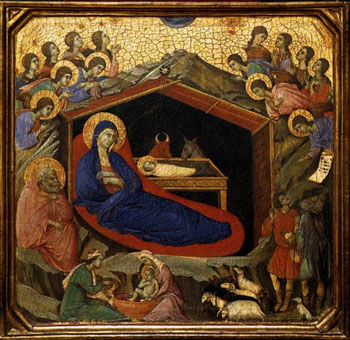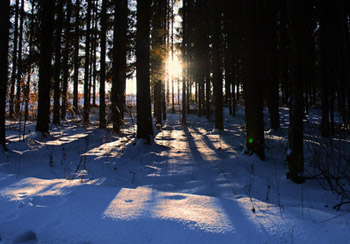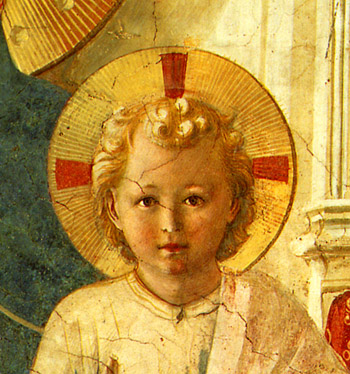The Mystery of Christmas
Everything is mystery in this holy season. The Word of God, whose generation is before the day-star, is born in time: A Child is God. A Virgin becomes a Mother and remains a Virgin. Things divine are commingled with those that are human. And the sublime, the ineffable antithesis, expressed by the Beloved Disciple in those words of his Gospel, The Word was made flesh, is repeated in a thousand different ways in all the prayers of the Church.
And rightly so, for it admirably embodies the whole of the great portent that unites in one Person the nature of Man and the nature of God.
The splendor of this mystery dazzles the understanding, but it inundates the heart with joy. It is the consummation of the designs of God in time. It is the endless subject of admiration and wonder to the Angels and Saints. Nay, it is the source and cause of their beatitude. Let us see how the Church offers this mystery to her children, veiled under the symbolism of the Liturgy.
Why the 25th of December?
The four weeks of our preparation are over. They were the image of the 4,000 years that preceded the great coming, and we have reached the 25th day of the month of December as a long desired place of sweetest rest. But, why is it that the celebration of our Savior's Birth should be the perpetual privilege of this one fixed day, while the whole liturgical cycle has to be changed and remodeled every year in order to yield to that ever-varying day which is to be the feast of His Resurrection, Easter Sunday?
 Adoring Christ on December 25
The question is a very natural one, and we find it proposed and answered as far back as the fourth century by St. Augustine in his celebrated Epistle to Januarius. The holy Doctor offers this explanation: We solemnize the day of our Savior's Birth so that we may honor that Birth, which was for our salvation. But, the precise day of the week on which He was born is void of any mystical signification. … We should not suppose, however, that because the Feast of Jesus' Birth is not fixed to any particular day of the week, there is no mystery expressed by its always being on the 25th of December.
Adoring Christ on December 25
The question is a very natural one, and we find it proposed and answered as far back as the fourth century by St. Augustine in his celebrated Epistle to Januarius. The holy Doctor offers this explanation: We solemnize the day of our Savior's Birth so that we may honor that Birth, which was for our salvation. But, the precise day of the week on which He was born is void of any mystical signification. … We should not suppose, however, that because the Feast of Jesus' Birth is not fixed to any particular day of the week, there is no mystery expressed by its always being on the 25th of December.
First, we may observe, with the old liturgists, that the Feast of Christmas is kept by turns on each of the days of the week, that thus its holiness may cleanse and rid them of the curse that Adam's sin had put upon them.
Second, the great mystery of the 25th of December being the Feast of our Savior's Birth refers not to the division of time marked out by God himself, but to the course of that great luminary that gives life to the world, because it gives light and warmth. Jesus, our Savior, the Light of the World, was born when the night of idolatry and crime was at its darkest. The day of His Birth, the 25th of December, is the time when the material sun begins to gain its ascendancy over the reign of gloomy night and show to the world its triumph of brightness.
In our Advent, we showed, following the Holy Fathers, that the diminution of physical light may be considered as emblematic of those dismal times which preceded the Incarnation. We joined our prayers with those of the people of the Old Testament, and with our Holy Mother the Church we cried out to the Divine Orient, the Sun of Justice, that He would deign to come and deliver us from the twofold death of body and soul.
God has heard our prayers, and it is on the day of the Winter Solstice - which the pagans of old made so much of by their fears and rejoicings - that He gives us both the increase of the natural light and the One Who is the Light of our souls.
St. Gregory of Nyssa, St. Ambrose, St. Maximus of Turin, St. Leo, St. Bernard and the principal liturgists, dwell with complacency on this profound mystery, which the Creator of the universe has willed should mark both the natural and the supernatural world. We shall find the Church also making continual allusion to it during this season of Christmas, as she did in that of Advent.
‘Darkness decreases, light increases’
“On this the Day which the Lord hath made,” says St. Gregory of Nyssa, “darkness decreases, light increases and night is driven back again. No, brethren, it is not by chance, nor by any created will, that this natural change begins on the day when He shows himself in the brightness of His coming, which is the spiritual life of the world. It is nature revealing, under this symbol, a secret to those whose eye is quick enough to see it, that is, to those who are able to appreciate this circumstance of our Savior's coming.
 A light appears in the darkness of winter
“Nature seems to me to say: ‘Know, O man! that under the things that I show thee, mysteries lie concealed. Hast thou not seen the night that had grown so long suddenly checked? Learn hence, that the black night of sin, which had reached its height by the accumulation of every guilty device, is this day stopped in its course. Yes, from this day forward its duration shall be shortened, until at length there shall be naught but light. Look, I pray thee, on the sun; and see how his rays are stronger, and his position higher in the heavens: Learn from that how the other light, the light of the Gospel, is now shedding itself over the whole earth.”
A light appears in the darkness of winter
“Nature seems to me to say: ‘Know, O man! that under the things that I show thee, mysteries lie concealed. Hast thou not seen the night that had grown so long suddenly checked? Learn hence, that the black night of sin, which had reached its height by the accumulation of every guilty device, is this day stopped in its course. Yes, from this day forward its duration shall be shortened, until at length there shall be naught but light. Look, I pray thee, on the sun; and see how his rays are stronger, and his position higher in the heavens: Learn from that how the other light, the light of the Gospel, is now shedding itself over the whole earth.”
“Let us rejoice, my Brethren,” cries out St. Augustine. “This day is sacred not because of the visible sun, but because of the Birth of He who is the invisible Creator of the sun... He chose this day whereon to be born, as He chose the Mother of whom to be born, and He bade both the day and the Mother. The day He chose was that on which the light begins to increase, and it typifies the work of Christ, Who renews our interior man day by day. For the eternal Creator, having willed to be born in time, His Birthday would necessarily be in harmony with the rest of His creation.”
The same St. Augustine, in another sermon for the same Feast, gives us the interpretation of a mysterious expression of St. John the Baptist, which admirably confirms the tradition of the Church. The great Precursor said on one occasion, when speaking of Christ: “He must increase, but I must decrease.”
 Christ, who is the Light of the world
These prophetic words signify, in their literal sense that the Baptist's mission was at its close because Jesus was entering upon His. But they convey, as St. Augustine assures us, a second meaning: “John came into this world at the season of the year when the length of the day decreases; Jesus was born in the season when the length of the day increases. Thus there is mystery both in the rising of that glorious star, the Baptist, at the summer solstice, and in the rising of our Divine Sun in the dark season of winter.”
Christ, who is the Light of the world
These prophetic words signify, in their literal sense that the Baptist's mission was at its close because Jesus was entering upon His. But they convey, as St. Augustine assures us, a second meaning: “John came into this world at the season of the year when the length of the day decreases; Jesus was born in the season when the length of the day increases. Thus there is mystery both in the rising of that glorious star, the Baptist, at the summer solstice, and in the rising of our Divine Sun in the dark season of winter.”
There have been men who dared to scoff at Christianity as superstition because they discovered that the ancient pagans used to keep a feast of the sun on the winter solstice. In their shallow erudition they concluded that a Religion could not be divinely instituted that had certain rites or customs originating in an analogy to certain phenomena of this world.
In other words, these writers denied what Revelation asserts, namely, that God only created this world for the sake of His Christ and His Church. The very facts which these enemies to the true Faith are, to us Catholics, additional proof of its being worthy of our most devoted love.
Thus, then, have we explained the fundamental mystery of these Forty Days of Christmas by having shown the grand secret hidden in the choice made by God's eternal decree, that the 25th day of December should be the Birthday of God upon this earth.
And rightly so, for it admirably embodies the whole of the great portent that unites in one Person the nature of Man and the nature of God.
The splendor of this mystery dazzles the understanding, but it inundates the heart with joy. It is the consummation of the designs of God in time. It is the endless subject of admiration and wonder to the Angels and Saints. Nay, it is the source and cause of their beatitude. Let us see how the Church offers this mystery to her children, veiled under the symbolism of the Liturgy.
Why the 25th of December?
The four weeks of our preparation are over. They were the image of the 4,000 years that preceded the great coming, and we have reached the 25th day of the month of December as a long desired place of sweetest rest. But, why is it that the celebration of our Savior's Birth should be the perpetual privilege of this one fixed day, while the whole liturgical cycle has to be changed and remodeled every year in order to yield to that ever-varying day which is to be the feast of His Resurrection, Easter Sunday?
 Adoring Christ on December 25
Adoring Christ on December 25First, we may observe, with the old liturgists, that the Feast of Christmas is kept by turns on each of the days of the week, that thus its holiness may cleanse and rid them of the curse that Adam's sin had put upon them.
Second, the great mystery of the 25th of December being the Feast of our Savior's Birth refers not to the division of time marked out by God himself, but to the course of that great luminary that gives life to the world, because it gives light and warmth. Jesus, our Savior, the Light of the World, was born when the night of idolatry and crime was at its darkest. The day of His Birth, the 25th of December, is the time when the material sun begins to gain its ascendancy over the reign of gloomy night and show to the world its triumph of brightness.
In our Advent, we showed, following the Holy Fathers, that the diminution of physical light may be considered as emblematic of those dismal times which preceded the Incarnation. We joined our prayers with those of the people of the Old Testament, and with our Holy Mother the Church we cried out to the Divine Orient, the Sun of Justice, that He would deign to come and deliver us from the twofold death of body and soul.
God has heard our prayers, and it is on the day of the Winter Solstice - which the pagans of old made so much of by their fears and rejoicings - that He gives us both the increase of the natural light and the One Who is the Light of our souls.
St. Gregory of Nyssa, St. Ambrose, St. Maximus of Turin, St. Leo, St. Bernard and the principal liturgists, dwell with complacency on this profound mystery, which the Creator of the universe has willed should mark both the natural and the supernatural world. We shall find the Church also making continual allusion to it during this season of Christmas, as she did in that of Advent.
‘Darkness decreases, light increases’
“On this the Day which the Lord hath made,” says St. Gregory of Nyssa, “darkness decreases, light increases and night is driven back again. No, brethren, it is not by chance, nor by any created will, that this natural change begins on the day when He shows himself in the brightness of His coming, which is the spiritual life of the world. It is nature revealing, under this symbol, a secret to those whose eye is quick enough to see it, that is, to those who are able to appreciate this circumstance of our Savior's coming.
 A light appears in the darkness of winter
A light appears in the darkness of winter“Let us rejoice, my Brethren,” cries out St. Augustine. “This day is sacred not because of the visible sun, but because of the Birth of He who is the invisible Creator of the sun... He chose this day whereon to be born, as He chose the Mother of whom to be born, and He bade both the day and the Mother. The day He chose was that on which the light begins to increase, and it typifies the work of Christ, Who renews our interior man day by day. For the eternal Creator, having willed to be born in time, His Birthday would necessarily be in harmony with the rest of His creation.”
The same St. Augustine, in another sermon for the same Feast, gives us the interpretation of a mysterious expression of St. John the Baptist, which admirably confirms the tradition of the Church. The great Precursor said on one occasion, when speaking of Christ: “He must increase, but I must decrease.”
 Christ, who is the Light of the world
Christ, who is the Light of the worldThere have been men who dared to scoff at Christianity as superstition because they discovered that the ancient pagans used to keep a feast of the sun on the winter solstice. In their shallow erudition they concluded that a Religion could not be divinely instituted that had certain rites or customs originating in an analogy to certain phenomena of this world.
In other words, these writers denied what Revelation asserts, namely, that God only created this world for the sake of His Christ and His Church. The very facts which these enemies to the true Faith are, to us Catholics, additional proof of its being worthy of our most devoted love.
Thus, then, have we explained the fundamental mystery of these Forty Days of Christmas by having shown the grand secret hidden in the choice made by God's eternal decree, that the 25th day of December should be the Birthday of God upon this earth.
